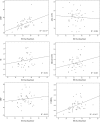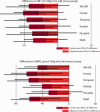Age-related changes in brain hemodynamics; A calibrated MRI study
- PMID: 26177724
- PMCID: PMC6869092
- DOI: 10.1002/hbm.22891
Age-related changes in brain hemodynamics; A calibrated MRI study
Abstract
Introduction: Blood oxygenation-level dependent (BOLD) magnetic resonance imaging signal changes in response to stimuli have been used to evaluate age-related changes in neuronal activity. Contradictory results from these types of experiments have been attributed to differences in cerebral blood flow (CBF) and cerebral metabolic rate of oxygen (CMRO2 ). To clarify the effects of these physiological parameters, we investigated the effect of age on baseline CBF and CMRO2 .
Materials and methods: Twenty young (mean ± sd age, 28 ± 3 years), and 45 older subjects (66 ± 4 years) were investigated. A dual-echo pseudocontinuous arterial spin labeling (ASL) sequence was performed during normocapnic, hypercapnic, and hyperoxic breathing challenges. Whole brain and regional gray matter values of CBF, ASL cerebrovascular reactivity (CVR), BOLD CVR, oxygen extraction fraction (OEF), and CMRO2 were calculated.
Results: Whole brain CBF was 49 ± 14 and 40 ± 9 ml/100 g/min in young and older subjects respectively (P < 0.05). Age-related differences in CBF decreased to the point of nonsignificance (B=-4.1, SE=3.8) when EtCO2 was added as a confounder. BOLD CVR was lower in the whole brain, in the frontal, in the temporal, and in the occipital of the older subjects (P<0.05). Whole brain OEF was 43 ± 8% in the young and 39 ± 6% in the older subjects (P = 0.066). Whole brain CMRO2 was 181 ± 60 and 133 ± 43 µmol/100 g/min in young and older subjects, respectively (P<0.01).
Discussion: Age-related differences in CBF could potentially be explained by differences in EtCO2 . Regional CMRO2 was lower in older subjects. BOLD studies should take this into account when investigating age-related changes in neuronal activity.
Keywords: ageing; calibrated magnetic resonance imaging; cerebral blood flow; cerebral metabolic rate of oxygen.
© 2015 Wiley Periodicals, Inc.
Figures







References
-
- Alsop DC, Detre JA, Golay X, Gunther M, Hendrikse J, Hernandez‐Garcia L, Lu H, MacIntosh BJ, Parkes LM, Smits M, van Osch MJ, Wang DJ, Wong EC Zaharchuk G: Recommended implementation of arterial spin‐labeled perfusion MRI for clinical applications: A consensus of the ISMRM perfusion study group and the European consortium for ASL in dementia. Magn Reson Med (in press). doi: 10.1002/mrm.25197 - DOI - PMC - PubMed
-
- Anderson JM, Hubbard BM, Coghill GR, Slidders W (1983): The effect of advanced old age on the neurone content of the cerebral cortex. Observations with an automatic image analyser point counting method. J Neurol Sci 58:235–246. - PubMed
-
- Andersson JLR, Jenkinson M, Smith S (2007): Non‐Linear Registration, Aka Spatial Normalisation. FMRIB Technical Report TR07JA2. Available at: http://www.fmrib.ox.ac.uk/analysis/techrep
Publication types
MeSH terms
Substances
LinkOut - more resources
Full Text Sources
Other Literature Sources

